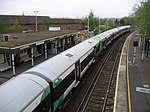West Street Baptist Church, East Grinstead
1810 establishments in England19th-century Baptist churches in the United Kingdom19th-century church buildings in EnglandBaptist churches in Mid Sussex DistrictChurches completed in 1811 ... and 3 more
Countess of Huntingdon's ConnexionGrade II listed churches in West SussexUse British English from May 2015

West Street Baptist Church (formerly Zion Chapel) is a Baptist church in East Grinstead, a town in the district of Mid Sussex, one of seven local government districts in the English county of West Sussex. Founded in 1810 as a chapel linked to the Countess of Huntingdon's Connexion, it was the first Nonconformist place of worship in East Grinstead; the town's subsequent development made it a local centre of both Protestant Nonconformity and alternative religions. The red-brick building is still used by a Baptist community, and is protected as a Grade II listed building.
Excerpt from the Wikipedia article West Street Baptist Church, East Grinstead (License: CC BY-SA 3.0, Authors, Images).West Street Baptist Church, East Grinstead
West Street, Mid Sussex Sunnyside
Geographical coordinates (GPS) Address Website External links Nearby Places Show on map
Geographical coordinates (GPS)
| Latitude | Longitude |
|---|---|
| N 51.1242 ° | E -0.0089 ° |
Address
West Street Baptist Church
West Street
RH19 4EY Mid Sussex, Sunnyside
England, United Kingdom
Open on Google Maps








